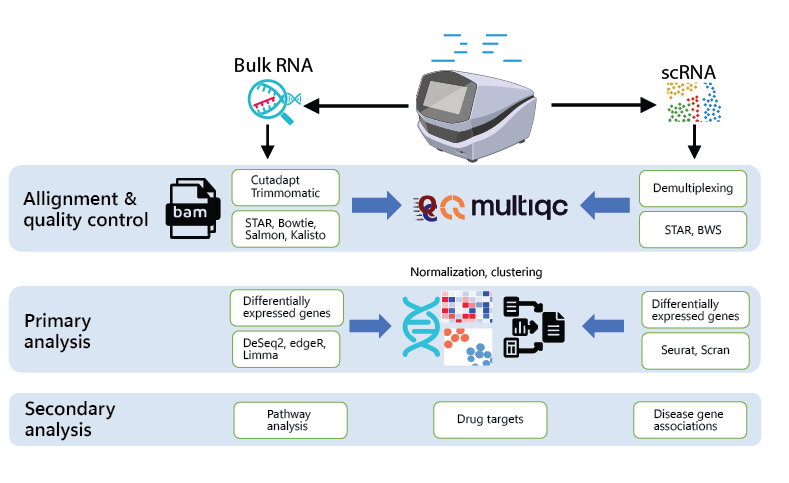- info@bioicawtech.com
- Helsinki, Finland
- Request a quote
Sequencing analysis
-
BioICAWTech > Sequencing analysis
Sequencing analysis
Scientists at BioICAWtech have developed several pipelines for analyzing bulk RNA, Whole exome sequencing and single cell sequencing.Following are some of the mostly commonly used steps by scientists at BioICAWtech.
- Raw Data Quality Control using FastQC
- Data cleaning using Trimmomatic and Cutadapt tools
- Alignment Tools
- Quantification
- Differential Expression Analysis (DE Analysis)
- Gene Set Enrichment Analysis (GSEA)
- Pathway analysis

Raw Data Quality Control using FastQC
FastQC provides a quick overview of the sequencing data quality, highlighting potential issues such as adapter contamination, overrepresented sequences, and base call quality.
Data cleaning using Trimmomatic and Cutadapt tools
We at BioICAWtech use several trimming Tools (e.g., Trimmomatic, Cutadapt) can remove adapter sequences, low-quality bases, and improve overall data quality.
Differential Expression Analysis
For DE analysis, we use DESeq2, edgeR, limma-voom tools. These tools can Identify genes that are differentially expressed between experimental conditions.
Alignment Tools
We use various alignment tools (e.g., STAR, HISAT2, TopHat) to align cleaned reads to a reference genome to determine the locations of the transcripts.
Quantification
We use several tools for quantification (e.g. HTSeq, Salmon, or StringTie) to quantify gene or transcript expression levels from the aligned reads.
Gene Set Enrichment Analysis
This analysis helps to identify whether a predefined set of genes shows statistically significant differences between experimental conditions.
Pathway analysis
We usually use Enrichr, DAVID, Reactome and KEGG tools to analyze the biological pathways that are enriched with differentially expressed genes.
It’s important to note that the choice of tools can depend on various factors such as the type of experiment, the organisms involved, and user preferences. Additionally, constant updates and new tools may become available, so it’s good practice to stay informed about the latest developments in RNA-seq analysis.
